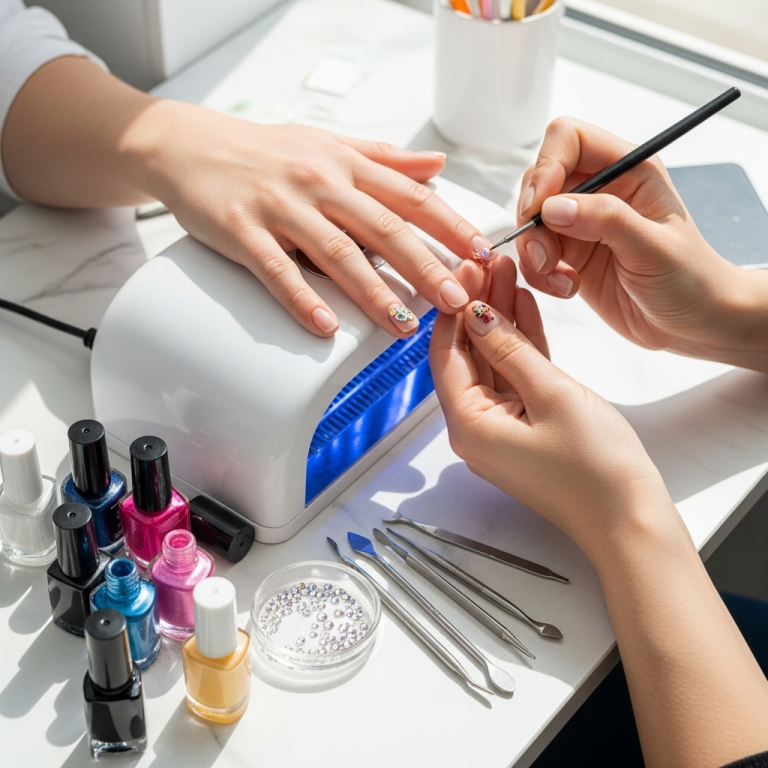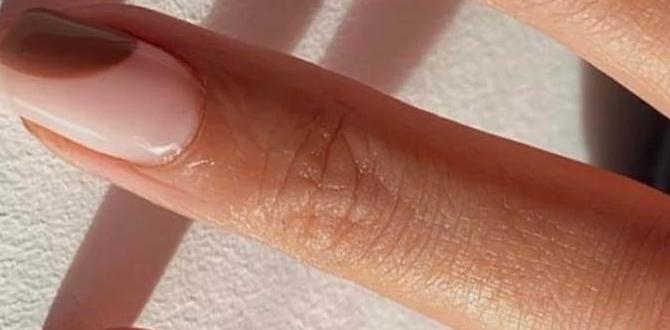Nail stamping design ideas for beginners are achievable with the right tools and simple techniques. Focus on basic patterns, clean application, and practice to create stunning, easy nail art.
Have you ever admired intricate nail art and thought, “I could never do that”? Nail stamping can seem intimidating, but it’s actually one of the easiest ways for beginners to achieve salon-worthy designs at home. Many people struggle with transferring tiny images cleanly or choosing the right tools, leading to frustration. But don’t worry! This guide is here to turn that frustration into fabulous, fun nail art. We’ll walk you through everything you need to know to get started with nail stamping, from essential supplies to simple design ideas that will make your nails pop. Get ready to unleash your inner nail artist!
What You’ll Need: Your Nail Stamping Starter Kit
Starting with nail stamping is much more accessible than you might think! You don’t need a professional salon’s worth of gear. A few key items will set you up for success. Think of these as your essential building blocks for creating beautiful stamped nails.
The Must-Have Tools
Stamping Plates: These metal discs (or sometimes plastic) are etched with various designs, from tiny florals to geometric patterns. For beginners, look for plates with larger, simpler images. This makes them easier to align and pick up. Brands like Mettee Nails offer a great selection of clearance plates that are perfect for practicing!
Stamping Polish: Regular nail polish can work, but dedicated stamping polish is thicker and more pigmented. This means it transfers the image more vividly and cleanly. It’s a game-changer for crisp designs!
Stamper: This is the silicone or jelly-like head that picks up the design from the plate and transfers it to your nail. They come in various shapes and sizes. A firm stamper is often easier for beginners to control.
Scraper Card: This is used to scrape off the excess stamping polish from your plate, leaving the polish only in the etched design. A firm plastic card, like an old gift card or a dedicated scraper card, works perfectly. Avoid anything too sharp or flexible.
Clean-Up Brush: A small, flat brush (like a small concealer brush or a dedicated nail art brush with synthetic bristles) dipped in nail polish remover is essential for cleaning up any stray polish around your cuticles and the edges of your nail after stamping.
Your Base and Top Coat
Base Coat: Always start with a good base coat. This protects your natural nail from staining and creates a smooth surface for your polish and stamped design.
Nail Polish for the Nail Bed: You’ll need a regular nail polish in a color that complements your stamped design. This is the color that will be underneath your stamped image.
Top Coat: A good, quick-drying top coat is crucial. It seals your design, prevents chipping, and gives your nails a glossy finish. Be careful not to use a top coat that’s too watery or too thick, as it can smudge your design if applied too aggressively.
Getting Started: Your First Stamped Manicure
Ready to dive in? Let’s break down the process step-by-step. It’s all about practice and patience, and you’ll be amazed at what you can create with a little guidance.
Step 1: Prep Your Nails
Clean your nails thoroughly to remove any oils or old polish.
Apply your favorite base coat and let it dry completely. A dry base coat helps prevent smudging.
Apply 1-2 coats of your chosen nail polish color for the nail bed. Make sure it’s completely dry before you move on to stamping. This is key! If your base color is still wet, the stamping image will likely smudge.
Step 2: Apply the Stamping Polish
Choose a design from your stamping plate.
Apply a generous amount of your dedicated stamping polish directly over the etched design. Don’t be shy with the polish; you want enough to fill the etching!
Step 3: Scrape Away Excess
Immediately after applying the polish, use your scraper card at a 45-degree angle.
Quickly and firmly scrape across the plate in one smooth motion. This removes the excess polish, leaving the design filled with polish in the etched lines. You want to go from one side of the design to the other.
Step 4: Stamp the Design
Now, quickly and gently roll your stamper over the scraped design. You want to pick up the image in one smooth motion.
If you miss any part of the design, don’t worry! You can try picking it up again or simply scrape the plate and try once more.
Pro Tip: Some find a straight down-and-up motion works best, while others prefer a slight rolling motion. Experiment to see what feels most comfortable and effective for you.
Step 5: Transfer to Nail
Immediately after picking up the design onto your stamper, gently roll or press the stamper onto your nail.
Aim to transfer the design onto your dried nail polish. Again, a gentle rolling or pressing motion is usually best. Avoid pressing too hard or wiggling the stamper, as this can cause the design to smudge.
Step 6: Clean Up and Seal
This is where your clean-up brush comes in handy! Dip it in nail polish remover and carefully clean up any polish that got onto your skin or cuticles.
Once everything is clean and smudge-free, apply a quick-drying top coat. Cap the edges of your nail with the top coat to help prevent chipping.
Be gentle when applying the top coat. A too-vigorous swipe can drag the stamped design.
Nail Stamping Design Ideas For Beginners: Easy and Chic
The beauty of nail stamping is the endless variety of designs! For beginners, starting with simple techniques and patterns will build your confidence. Here are some ideas that are forgiving and look fantastic.
Simple All-Over Patterns
Tiny Dots: Many plates have patterns of small dots. Stamping a full nail with a delicate dot pattern in a contrasting color can add texture and interest without being overwhelming.
Fine Lines: Thin, straight, or wavy lines can create a modern, graphic look. Try stamping a single accent nail or a full set for a chic vibe.
Geometric Shapes: Simple shapes like small squares, triangles, or tiny hearts are great for beginners. You can repeat them across the nail or use them strategically.
Leafy or Floral Silhouettes: Look for plates with simple outlines of leaves or flowers. These often stamp beautifully in a single color and look elegant.
Accent Nail Magic
Single Image: This is the easiest way to start. Pick one beautiful image from your plate and stamp it just on your ring finger or one accent nail. Pair it with a solid color polish on your other nails.
Small Cluster: Some plates have small clusters of motifs. You can stamp a few of these close together on an accent nail for a mini-scene.
Half Moon or Tip Design: Instead of a full nail stamp, try just stamping the design along the tip of your nail (like a French tip) or in the half-moon area at the base of your nail.
Easy Two-Color Stamping
This might sound advanced, but it’s simpler than you think!
Layering Ombre: Stamp a solid color image, let it dry, then stamp a slightly different colored image of the same design slightly off-center on top. This creates a subtle depth.
Color Filling: Stamp a design (like an outline of a flower) in one color. Once dry, use a fine nail art brush to fill in parts of the design with a different color polish. This is more advanced but can be done with simple shapes.
Seasonal Fun
Winter: Snowflakes, simple star patterns, or snowflakes with metallic stamping polish.
Spring/Summer: Small floral motifs, delicate vines, or tiny fruit shapes.
Fall: Leaf outlines, simple plaid patterns, or pumpkin shapes.
Holidays: Tiny hearts for Valentine’s Day, simple festive shapes for New Year’s Eve, or spooky but simple outlines for Halloween.
Tips for Nail Stamping Success: Troubleshooting & Tricks
Even with the best intentions, sometimes stamping can be a bit finicky! Here are some top tips to help you get perfect results every time.
The Importance of Speed and Pressure
Work Quickly: Stamping polish dries fast. Once you apply it to the plate, you need to scrape, stamp, and transfer without delay. Aim for a smooth, continuous flow.
Gentle Pressure: When scraping, hold the scraper card at a 45-degree angle and use firm but not excessive pressure. Too much pressure can scratch the plate or push polish into the wrong areas. When stamping onto the nail, a light, gentle roll or press is best.
Plate and Tool Care
Clean Your Plates: After each use, clean your stamping plates thoroughly with nail polish remover and a lint-free wipe or cotton pad. Make sure all polish residue is gone. Stubborn polish can be gently removed with a nail brush dipped in acetone.
Clean Your Stamper: Clean your stamper head by dabbing it onto a lint-free paper or sticky tape. Never use acetone directly on a silicone stamper, as it can damage the material. A quick roll on sticky tape is usually all it takes to remove polish.
Inspect Your Plates: Periodically check your plates for any deep scratches or damage. Minor surface scuffs are usually okay, but deep gouges can affect the design transfer.
Polish Consistency Matters
Dedicated Stamping Polish: As mentioned, this is often the easiest route for beginners. It’s formulated for opacity and thickness.
Regular Polish: If you’re using regular nail polish, look for formulas that are a bit thicker and more pigmented. Some brands are better for stamping than others. If your regular polish is too thin, it might not transfer the design well. You can sometimes thicken it slightly with nail polish thinner, but be cautious not to overdo it.
Sealing the Design: Make sure your image is fully dry before top-coating. A common mistake is applying top coat too soon, which causes the design to smudge.
Practice Makes Perfect
Use Practice Tips: Before stamping on your actual nails, practice on old nail tips or even on a piece of paper. This helps you get a feel for the speed, pressure, and polish amount needed without the pressure of messing up a manicure.
Start Simple: Begin with larger, bold designs on your plates before moving on to intricate patterns.
Don’t Be Afraid to Experiment: Try different color combinations or stamp over dark, light, and metallic bases. You might discover unexpected looks you love!
Common Nail Stamping Issues for Beginners (And How to Fix Them)
It’s completely normal to encounter a few hiccups when you’re starting out. Here’s a breakdown of common problems and their solutions.
| Problem | Why It Happens | Solution |
|---|---|---|
| Design isn’t picking up onto the stamper | Not enough polish, working too slowly, or stamper/plate is dirty. | Apply more polish, work faster. Ensure both stamper and plate are perfectly clean. Try a different polish. |
| Design is faint or incomplete on the nail | Polish dried before transfer, too much pressure when scraping, or not enough polish on the plate. | Work faster between scraping and stamping. Scrape more gently. Apply a slightly more generous amount of polish. |
| Design smudges when transferring to the nail | Base polish is too wet, or too much pressure/wiggling when stamping. | Ensure base color is completely dry. Use a light, gentle press or roll motion. Don’t wiggle the stamper. |
| Design smudges when applying top coat | Top coat applied too soon, or top coat is too viscous (thick/sticky). | Wait until the stamped design is fully dry (at least 30 seconds, often longer). Use a fast-drying top coat. Apply top coat gently, capping the edges. |
| Stray polish around cuticles | Messy application of base polish or stamping. | Use a clean-up brush dipped in nail polish remover to carefully erase any excess polish around the cuticle area after stamping and before applying top coat. Alternatively, apply liquid latex around your cuticles before stamping to create a barrier. |
Advanced Beginner Techniques to Try Next
Once you’re comfortable with the basics, you might be eager to try a few slightly more advanced techniques. These will add even more flair to your nail art:
Reverse Stamping
This technique involves stamping an image onto your stamper, then using a fine brush and polish to “fill in” or colorize the design on the stamper*. Once the color is dry, you transfer the entire colored image to your nail. It allows for multi-colored designs with crisp lines.
Creating Decals
You can stamp an image onto a plastic surface (like a stencil sheet or a ziplock bag) and let it dry. Then, carefully peel the entire design off the surface. You can then adhere this “decal” to your nail. This is great for placing a design precisely or for combining multiple small images.
Layering and Combinations
Don’t be afraid to combine different stamping designs from various plates or even layer them on top of each other. For instance, you could stamp a delicate floral pattern and then add tiny dots within the “petals” using a fine nail art brush. You can also combine stamping with freehand nail art elements!
Frequently Asked Questions About Nail Stamping
What is the best type of plate for beginners?
For beginners, it’s best to start with stamping plates that have larger, simpler designs. Look for full nail designs or individual elements that are bold and have clear, deep etching. Plates with many tiny, intricate details can be challenging to pick up cleanly at first. Many brands offer “starter” or “beginner” plates designed for easier use.
Do I really need special stamping polish?
While you can achieve results with regular nail polish, dedicated stamping polish is highly recommended,



